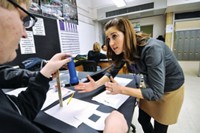Advertisement
Grab your lab coat. Let's get started
Welcome!
Welcome!
Create an account below to get 6 C&EN articles per month, receive newsletters and more - all free.
It seems this is your first time logging in online. Please enter the following information to continue.
As an ACS member you automatically get access to this site. All we need is few more details to create your reading experience.
Not you? Sign in with a different account.
Not you? Sign in with a different account.
ERROR 1
ERROR 1
ERROR 2
ERROR 2
ERROR 2
ERROR 2
ERROR 2
Password and Confirm password must match.
If you have an ACS member number, please enter it here so we can link this account to your membership. (optional)
ERROR 2
ACS values your privacy. By submitting your information, you are gaining access to C&EN and subscribing to our weekly newsletter. We use the information you provide to make your reading experience better, and we will never sell your data to third party members.
Policy
The Joys And Trials Of Teaching
April 13, 2009
| A version of this story appeared in
Volume 87, Issue 15
I AM A PH.D. CHEMIST from Columbia University who spent several years in the pharmaceutical industry in New Jersey but now teach AP Chemistry at the public Lowell High School in San Francisco. I agree with or have experienced just about everything "Head of the Class" covers (C&EN, Jan. 19, page 81). However, I do think the following reflects a problem with the American Chemical Society: "A Ph.D. chemist who wants to pursue a career as a high school teacher will be in good company. A quick search by C&EN turned up more than a dozen Ph.D. chemists at public and private high schools around the country."
A dozen or two people across the entire country are not "in good company." I think the article is drastically undercounting. For example, I wouldn't show up in the ACS database since I'm not an ACS member. I regretfully dropped my membership soon after leaving industry because it cost so much. It cost on the order of $140 per year with few direct benefits besides C&EN and the potential of a discount on the Journal of Chemical Education. I had been an ACS member as a college student and grad student because of relevancy and deep student discounts. When I worked in industry, not only was I paid well, but the company also paid for membership in one society.
Now that I am a public school teacher, the pay is less, membership costs are not covered, and there is no discount from ACS for K–12 teachers. Many aspects of my high school teaching job are not frustrating, but the high cost of ACS membership for K–12 teachers is. A full year's membership to the National Science Teachers Association, which is more directly relevant in many ways for K–12 teaching, costs $74, about half of the ACS membership cost, and also includes a member magazine and a discount for a highly relevant national conference.
If ACS wants to add to its database of Ph.D. K–12 teachers beyond the dozen or so now apparently in the entire U.S., I respectfully suggest it reduce the membership fees or provide a C&EN-only membership or do something else creative.
Bryan Marten
Albany, Calif.
I RECENTLY RETIRED at 69 after 10 years of teaching chemistry in a public high school, prior to which I had spent decades as an industrial chemist. I earned my credential while I taught through an alternative-certification program.
My teaching years were by far the most rewarding of my working life—and also the most demanding. The workweek was consistently 55 to 60 hours and involved most of my weekends, the students did not always want to learn, and no experience I ever had in the "real world" prepared me for finding that after I had closed the door at the bell I was now the lone adult in a roomful of judgmental adolescents.
Notwithstanding the first year, however, it was an experience I treasure.
Godfrey Crane
Las Cruces, N.M.




Join the conversation
Contact the reporter
Submit a Letter to the Editor for publication
Engage with us on Twitter